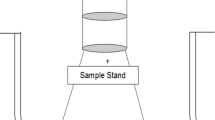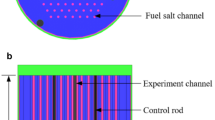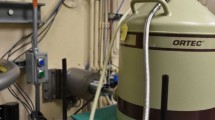Abstract
Accurate knowledge of the total mass of molten salts both for pyroprocessing spent nuclear fuels and for molten salt reactors is necessary for safeguards purposes. However, it is challenging to know or measure the total mass of molten salt due to the complicated shapes as well as the compositional—and thus density—changes that occur over time during operation. In this paper, we investigated radioactive tracer dilution (RTD) as a potential safeguards technique for application to the total mass measurement of LiCl–KCl–UCl3 salt used for uranium electrorefining, with a focus on the feasibility, uncertainty, and fission product effect of RTD for salt mass measurement. To this end, experimental-scale RTD tests (600–700 g of total mass) were initially carried out by adding 22Na tracer salt into LiCl–KCl salt containing 0, 5, and 28wt% radioactive salts from an electrorefiner (ER) for refining uranium. Upon the completion of the experimental-scale RTD tests, we performed a scale-up RTD test by directly adding 22Na tracer salts to the ER, which uses about 12 kg of LiCl–KCl–UCl3 salt during normal operation. This paper reports the main features of RTD for total mass measurement of molten salt and summarizes the results of the experimental-scale and scale-up RTD tests.








Similar content being viewed by others
References
Choi EY, Jeong SM (2015) Electrochemical processing of spent nuclear fuels: an overview of oxide reduction in pyroprocessing technology. Prog Nat Sci Mater Int 25:572–582. https://doi.org/10.1016/j.pnsc.2015.11.001
Jeong SM, Park BH, Hur J-M, Seo C-S, Lee H, Song K-C (2010) An experimental study on an electrochemical reduction of an oxide mixture in the advanced spent-fuel conditioning process. Nucl Eng Technol 42:183–192
Herrmann SD, Li SX, Simpson MF, Phongikaroon S (2006) Electrolytic reduction of spent nuclear oxide fuel as part of an integral process to separate and recover actinides from fission products. Sep Sci Technol 41:1965–1983. https://doi.org/10.1080/01496390600745602
Jeong SM, Shin HS, Cho SH, Hur JM, Lee HS (2009) Electrochemical behavior of a platinum anode for reduction of uranium oxide in a LiCl molten salt. Electrochim Acta 54:6335–6340. https://doi.org/10.1016/j.electacta.2009.05.080
Williams AN, Cao G, Shaltry MR (2021) Voltammetry measurements in lithium chloride-lithium oxide (LiCl–Li2O) salt: An evaluation of working electrode materials. J Nucl Mater 546:152760. https://doi.org/10.1016/j.jnucmat.2020.152760
Li SX, Johnson TA, Westphal BR, Goff KM, Benedict RW (2005) Electrorefining experience for pyrochemical processing of spent EBR-II driver fuel. In: Proc. Glob. 2005, Tsukuba, Japan
Fredrickson GL, Patterson MN, Vaden DE, Galbreth GG, Yoo TS, Price JC, Flynn EJ, Searle RN (2022) History and status of spent fuel treatment at the INL fuel conditioning facility. Prog Nucl Energy 143:104037. https://doi.org/10.1016/j.pnucene.2021.104037
Grimes WR (1970) Molten-salt reactor chemistry. Nucl Appl Technol 8:137–155. https://doi.org/10.13182/nt70-a28621
Zweibaum N, Cao G, Cisneros AT, Kelleher B, Laufer MR, Scarlat RO, Seifried JE, Anderson MH, Forsberg CW, Greenspan E, Hu LW, Peterson PF, Sridharan K (2014) Phenomenology, methods and experimental program for fluoride-salt-cooled, high-temperature reactors (FHRs). Prog Nucl Energy 77:390–405. https://doi.org/10.1016/j.pnucene.2014.04.008
Beneš O, Konings RJM (2012) Molten salt reactor fuel and coolant. Elsevier, New Jersey. https://doi.org/10.1016/B978-0-08-056033-5.00062-8
Serp J, Allibert M, Beneš O, Delpech S, Feynberg O, Ghetta V, Heuer D, Holcomb D, Ignatiev V, Kloosterman JL, Luzzi L, Merle-Lucotte E, Uhlíř J, Yoshioka R, Zhimin D (2014) The molten salt reactor (MSR) in generation IV: overview and perspectives. Prog Nucl Energy 77:308–319. https://doi.org/10.1016/j.pnucene.2014.02.014
Fredrickson G, Cao G, Gakhar R, Yoo T (2018) Molten salt reactor salt processing–technology status. INL/EXT-18–51033
Li SX, Sanders J, Cao LR (2018) Application of radioactive tracer dilution technique on determination of molten salt mass in containers with irregular shape, INL/MIS-18–51089-Revision-0
Hardtmayer D, Herminghuysen K, White S, Kauffman A, Sanders J, Li S, Cao L (2018) Determination of molten salt mass using 22Na tracer mixed with 154Eu and 137Cs. J Radioanal Nucl Chem 318:457–463. https://doi.org/10.1007/s10967-018-5995-x
Cao L, Jarrell J, White S, Herminghuysen K, Kauffman A, Hardtmayer DE, Sanders J, Li S (2017) A radioactive tracer dilution method to determine the mass of molten salt. J Radioanal Nucl Chem 314:387–393. https://doi.org/10.1007/s10967-017-5417-5
Cao G, Larson N, Storms B, Kandlakunta P, Cao LR, Li S (2022) Gamma-ray spectra analyses of molten salts in spent nuclear fuels pyroprocessing facilities for mass measurement. J Radioanal Nucl Chem. https://doi.org/10.1007/s10967-022-08339-5
Durham RW, Martin GR, Sutton HC (1949) A radioactive tracer method for the analysis of mixtures of short-lived free radicals. Nature 164:1052–1053
Gore GL, Terry LL (1956) Radioactive tracer techniques. J Pet Technol 8:12–17. https://doi.org/10.2118/654-g
Singare PU, Lokhande RS, Patil AB (2008) Application of radioactive tracer technique for characterization of some strongly basic anion exchange resins. Radiochim Acta 96:99–104. https://doi.org/10.1524/ract.2008.1465
Lokhande RS, Singare PU, Patil VV (2008) Application of radioactive tracer technique to study the kinetics and mechanism of reversible ion-isotope exchange with strongly basic anion-exchange resin Indion-850. Radiochemistry 50:638–641. https://doi.org/10.1134/S1066362208060106
Kirkuo L, Frenkel RB (2006) An introduction to uncertainty in measurement: using the GUM (guide to the expression of uncertainty in measurement). Cambridge University Press, Cambridge
Knoll GF (2010) Radiation detection and measurement. John Wiley & Sons, Inc. Fourth
Zhang C, Simpson MF (2017) Density of molten salt mixtures of eutectic LiCl-KCl Containing UCl3, CeCl3, or LaCl3. J Nucl Fuel Cycle Waste Technol 15:117–124. https://doi.org/10.7733/jnfcwt.2017.15.2.117
Zhang H, Li SX, Simpson MF (2022) Testing of an element tracer dilution method for measurement of total mass of molten salt in a nuclear fuel cycle process or molten salt reactor. Nucl Technol 208:494–502. https://doi.org/10.1080/00295450.2021.1913031
Tylka MM, Willit JL, Williamson MA, Prakash J (2013) Voltammetry for quantitative analysis of actinides in molten salts. In: 224th ECS Meet.
Hoyt NC, Willit JL, Williamson MA (2017) Communication—quantitative voltammetric analysis of high concentration actinides in molten salts. J Electrochem Soc 164:H134–H136. https://doi.org/10.1149/2.1481702jes
Hoyt NC, Guo J, Stricker EA, Williamson MA (2019) Online monitoring of molten salt reactors. In: NRC Adv React Workshop
Acknowledgements
This work was supported by the U.S. Department of Energy (DOE), Office of Nuclear Energy, under DOE Idaho Operations Office contract number DE-AC07-05ID14517. Accordingly, the U.S. Government retains and the publisher, by accepting the article for publication, acknowledges that the U.S. Government retains a nonexclusive, paid-up, irrevocable, worldwide license to publish or reproduce the published form of this manuscript or allow others to do so, for U.S. Government purposes.
Funding
This work was financially sponsored by DOE’s Materials Protection Accounting and Control Technologies (MPACT) program. The authors thank Skyler James, Tim Malewitz, and Steven Herrmann for their support and assistance in successfully completing experiments conducted in HFEF hot cell.
Author information
Authors and Affiliations
Corresponding author
Ethics declarations
Conflict of interest
The authors declare that they have no conflict of interest.
Additional information
Publisher's Note
Springer Nature remains neutral with regard to jurisdictional claims in published maps and institutional affiliations.
Rights and permissions
Springer Nature or its licensor (e.g. a society or other partner) holds exclusive rights to this article under a publishing agreement with the author(s) or other rightsholder(s); author self-archiving of the accepted manuscript version of this article is solely governed by the terms of such publishing agreement and applicable law.
About this article
Cite this article
Cao, G., Storms, B., Coleman, M.E. et al. Development, feasibility, and uncertainty of radioactive 22Na tracer dilution and gamma spectroscopy for mass determination of molten salt for pyroprocessing spent nuclear fuels. J Radioanal Nucl Chem 332, 723–735 (2023). https://doi.org/10.1007/s10967-023-08790-y
Received:
Accepted:
Published:
Issue Date:
DOI: https://doi.org/10.1007/s10967-023-08790-y




